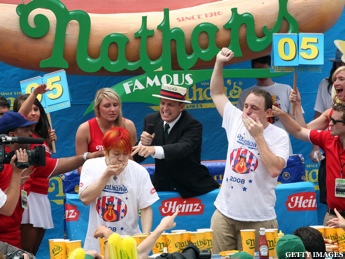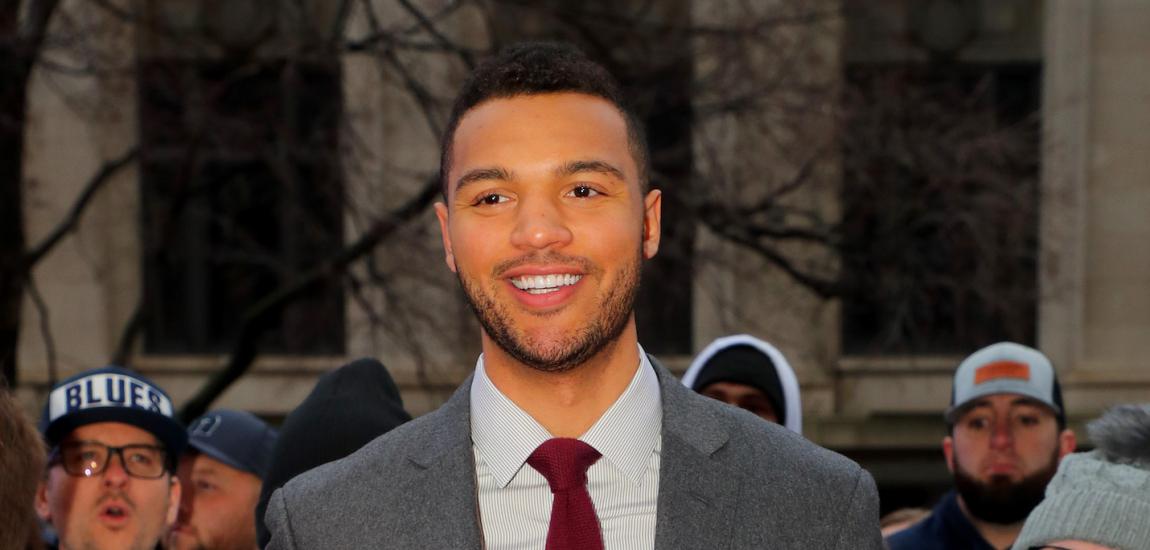
In an article in 1958 celebrating the patriotic treat of the masses, the hot dog, Sports Illustrated writer Evan Jones waxed some beautiful poetic:
The hot dog is nostalgic. It is legendary, so legendary that it has been said that it was invented in Frankfurt am Main in the 16th century, or that the first of its kind was made from dog meat at the command of Frederick the Great during the Seven Years' War, or that the Frankfurt Butchers Guild produced the original, in the shape of a dachshund, in 1852. In the Odyssey, the sausage line leads back to the ninth century B.C., when Homer wrote: "As when a man near a great glowing fire turns to and fro a sausage, full of fat and blood, anxious to have it quickly roasted; so to and fro Odysseus tossed, and pondered how to lay hands upon the shameless suitors."
Little did he know that decades later, a tradition of patriotism in the name of American gluttony would involve trained professionals scarfing down as many hot dogs and buns as they could in the annual Nathan’s Hot Dog Competition.
As they have done nearly every year (it's been interrupted for reasons like war and protests), competitors will line up on Coney Island for the competition on Thursday, to be broadcast for the ninth year on ESPN beginning at noon ET.
The competition, however, bears little resemblance to the first one held on the boardwalk in the early part of last century.
Even in the decade since ESPN first discussed covering the competition with Major League Eating (a meeting done over lunch, of course), the competition has grown from attracting just over 25,000 fans to more than 50,000, thanks in large part to the league and the sports network.
The strategy has changed and become more practiced. The hot dog counter itself has changed. It’s also gone from a competition won by the people you’d think would win it: Large men who seem like they've just eaten a lot of hot dogs in their time to smaller fitter champions like this year's favorite and three-time defending champion Joey Chestnut. And it's been plagued with accusations and controversies from one former champion banned because of a disagreement over sponsorship agreements.

For its part, ESPN says it has tried to keep the competition as close to its roots as possible.
"Our approach, as it is for most championship events, we want to showcase the event as it is" said Jason Bernstein, senior director of programming and acquisitions at ESPN. "Therefore when we talked with them (a decade ago) we spent a lot of time then and over the years on how we can capture their moments without interfering in the competition."
The byproducts of what the coverage on ESPN has brought are only natural: There's more attention paid to it and the stakes get higher because there's naturally more chance for money involved. (For more on one major consequence, see the sad tale of why the contest has had to go on without Chestnut's top rival.)
But what hasn’t changed is why people love it. The key to the popularity, said Bernstein is its simplicity and the short amount of actual time fans have to invest in it -- at least from their home (10 minutes).
"It's hot dogs on Fourth of July," he added. “Everyone loves hot dogs on the Fourth of July, even vegetarians who can have tofu dogs for the holiday.”
Below, a video of New York Mayor Michael Bloomberg, participating in the 2012 weigh-in.




